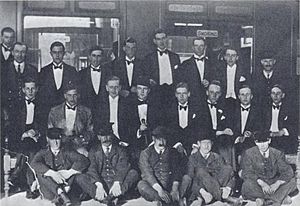Roy Harrod facts for kids
Quick facts for kids
Sir Roy Harrod
|
|
|---|---|

The Railway Club. (Left to right) Back: Henry Yorke, Roy Harrod, Henry Weymouth, David Plunket Greene, Harry Stavordale, Brian Howard. Middle row: Michael Rosse, John Sutro, Hugh Lygon, Harold Acton, Bryan Guinness, Patrick Balfour, Mark Ogilvie-Grant, Johnny Drury-Lowe. Front: porters
|
|
| Born | 13 February 1900 London, England
|
| Died | 8 March 1978 (aged 78) Holt, Norfolk, England
|
| Spouse(s) | Billa Harrod |
| School or tradition |
Post-Keynesian economics |
| Alma mater | New College, Oxford, King's College, Cambridge |
| Influences | John Maynard Keynes, John A. Hobson |
| Contributions | Harrod–Domar model |
Sir Henry Roy Forbes Harrod (born February 13, 1900 – died March 8, 1978) was an English economist. An economist studies how people and societies make choices about money, resources, and goods. Harrod is famous for two main things. First, he wrote an important book called The Life of John Maynard Keynes (1951). This book was about his friend, another very famous economist. Second, he helped create the Harrod–Domar model. This is a way to understand how economies grow. He worked on this idea with another economist named Evsey Domar. Harrod also wrote a well-known textbook called International Economics.
About Roy Harrod
Roy Harrod was born in London, England. He went to two good schools, St Paul's School and Westminster School. After that, he studied history at New College, Oxford in the University of Oxford. He was very good at his studies. In 1922, he spent some time at King's College, Cambridge. It was there that he met and became good friends with John Maynard Keynes.
After his time in Cambridge, Harrod went back to Oxford. He became a teacher and researcher in economics at Christ Church, Oxford. He taught there for many years, until 1967. He stayed in touch with Keynes until Keynes passed away in 1946. Later, Harrod wrote the first major book about Keynes's life. Harrod was also a researcher at Nuffield College, Oxford for several years.
At Oxford, Harrod was part of a group called the Railway Club. This club included many of his friends and other notable people. During World War II, he worked for a short time in a special statistics group for Winston Churchill. This group was part of the British Navy.
In 1966, Harrod won a special award called the Bernhard-Harms-Preis. After he retired in 1967, he moved to a town called Holt, Norfolk. Many experts believe that if Roy Harrod had lived longer, he would have won the Nobel Memorial Prize in Economic Sciences.
Harrod married Wilhelmine "Billa" Cresswell in 1938. They had a son named Dominick Harrod, who became a reporter for the BBC, focusing on economics.
Writing About John Maynard Keynes
After his friend and fellow economist John Maynard Keynes died in 1946, Roy Harrod helped write a long article about Keynes for an economics magazine. Keynes's family then encouraged Harrod to write a full book about his life.
The book, The Life of John Maynard Keynes, came out in 1951. Many people praised it. At that time, most of Keynes's family and friends were still alive. Keynes was a very influential economist, and his ideas, known as Keynesian economics, were important after the war. Because of this, people were very interested in his life.
Later, other authors wrote more books about Keynes. These books added new details and sometimes offered different views of Keynes compared to Harrod's book.
Legacy
Roy Harrod's important papers and writings are kept at the British Library. Anyone interested can look at them there.
See also
 In Spanish: Roy Harrod para niños
In Spanish: Roy Harrod para niños

